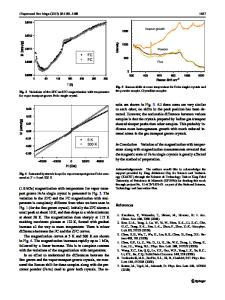Magnetic properties of melt-textured DyBCO single domains
- PDF / 469,550 Bytes
- 6 Pages / 612 x 792 pts (letter) Page_size
- 81 Downloads / 260 Views
Magnetic properties of melt-textured DyBCO single domains Philippe Vanderbemden 1, Marcel Ausloos 2 and Rudi Cloots 3 University of Liège, S.U.P.R.A.S., 1 Montefiore Electricity Institute B28, 2 Physics Institute B5, 3 Chemistry Institute B6, Sart-Tilman, B-4000 Liège, Belgium.
ABSTRACT This communication aims at reporting the superconducting properties of several bulk meltprocessed DyBa2Cu3O7-x samples determined by using various measuring techniques. The original single domain material was first cut into 9 similar cubic samples which have been characterized by AC susceptibility, flux profiles and DC magnetization. The results indicate good quality meltprocessed (RE)BCO materials with Tc ≈89 K. Next, the effect of post oxygen annealing treatments on these samples was studied. The influence of the non-uniformity of the oxygen content on the magnetic property anisotropy is discussed. Finally, additional magnetic measurements were carried out by using a couple of parallel pick-up coils wound on the same sample. From the results we conclude that geometric effects have to be taken into account in order to extract the critical current density from the magnetic properties.
INTRODUCTION Bulk melt-textured (RE)BCO materials (RE = Y, Nd, Dy, ...) have been shown to be promising candidates for several engineering applications [1-4]. The present communication concentrates on the magnetic properties of DyBCO single domains. The purpose is to present some appropriate experiments which can be used for investigating (i) the non-uniformity of oxygen content and (ii) the geometric effects. It will be shown that both effects have to be considered for understanding the measurement results.
EXPERIMENTAL TECHNIQUES The precursors used for melt-processing were prepared from a powder having a DyBa2Cu3O7 + 20% Dy2BaCuO5 stoechiometry and sintered through a classical solid-state route. A NdBa2Cu3O7 seed was placed on the top of the sintered precursor body which was heated to 1010°C to peritectically decompose the DyBCO phase. The sample was then crystallized by slow cooling at 1°C / hour. A Dy2O3 substrate was also used in order to accelerate the growing of the 123 single grain. This technique allows DyBCO single domains up to 3 cm diameter to be routinely fabricated. Specific features resulting from the growth process have been extensively discussed by Cloots et al. [5]. Following the growth process, the single domains were annealed in flowing O2 between 400 °C and 500 °C for 150 hours, which is hereafter referred to as the classical oxygen annealing II8.4.1
cycle. This treatment was found to ensure a good and uniform oxygen level within the samples. After being measured, some samples were subjected to further annealing in flowing O2 at 500 °C, which we refer to as post annealing treatement. In order to ensure the reproducibility of the results, a DyBCO single domain was cut into 9 cubic samples of dimensions ≈2 x 2 x 2 mm3, with their edges aligned with respect to the crystallographic directions of the single-domain. Magnetization lo
Data Loading...











